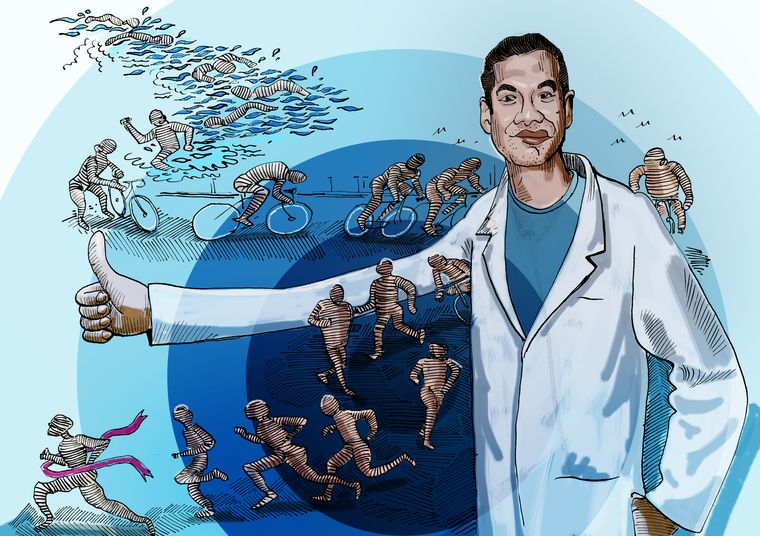There are four types of triathlon races, which involve progressively longer distances and four types of personalities. The sprint (a little crazy), Olympic (crazy), Ironman 70.3 (out-there crazy) and Ironman 140.6 (completely nuts). St. Anthony’s was my first Olympic Triathlon, which involved a 1.5km swim, 40km bike and 10km run. As a USA Triathlon race, there is no music allowed. The swim was out in the Tampa Bay on the west coast of Florida and I had heard enough horror stories about the waves to have me concerned.
One of the difficulties of entering an event is trying to tie it in with work and family. My wife was out of town and I had the kids. I called the coordinator and asked whether the kids could volunteer. “Sure, who would be the adult supervising them?” she asked. “I have a 17 year old,” I replied hesitantly. “Sir, we aren’t a babysitting service,” she replied. “They are good kids,” I added. She must have heard the desperation in my voice, and relented. “Ok, fine,” she said. “I will keep an eye on them.” The kids needed volunteer hours and were thrilled to be able to see the professionals up close and personal.
From a medical standpoint, there is a certain game plan for the longer races. For the shorter sprints, you can get into the high aerobic to anaerobic (high-intensity) zones early on. A rough guide to maximum heart rate is 220 minus age. Anything over 90 per cent will put you into the anaerobic zone pretty quickly. The problem with anaerobic zone heart rates is the sustainability. You use more energy than your oxygen intake, generating progressively more lactic acid, eventually leading to fatigue.
That morning, the ocean was flat. Perfect conditions. The professional’s gun went off at 6.50am. I watched them glide effortlessly through the water, with kayaks following. My swim group start was at 7.20am (45-49 age group). We were corralled together at 7.10am. I looked at the 100 or so athletes in my age group and was overwhelmed. These were tough, hard men who seemed to know what they were doing. I was pretty sure I would be last in this group. I looked at my heart rate and it was already at 120 bpm.
We got into chest-high water five minutes before our start. The ocean in front seemed endless and I heard the announcer say that the leader was already out of the water. The gun went off at 7.20am and we were off. The swim portion can be vicious. You can get kicked in the face, pulled under or swum over. I started behind the pack to avoid these shenanigans. Nice and easy, I repeated my coach’s words and I felt good gliding, till I ran into a wall of kicking legs. I realised I wasn’t the slowest, as I manoeuvred around legs aiming to maim me. Game on, I thought to myself and I started to race. I didn’t know it then, but I had made a cardinal sin. Without realising it, my heart rate had gone into the anaerobic zone, my stroke shortened and I was fighting with the water instead of gliding. It was a full-on melee in there, and when I came up one time after being pulled under, I saw the lifeguards smiling and enjoying the spectacle.
I came out of the swim, glanced at my heart rate, which was up to 175 bpm. I was cooking myself. As I got onto the bike, I saw the professionals coming in to finish. It was a sight, they were pushing 30mph and looking effortless. You don’t have to go to a movie to see a superhero; just go to a triathlon and watch the professionals. The time taken by the leader to get out of the ocean, run to his bike, collect it and run to the bike start was under a minute. Mine was 4.30.
The body has energy storage for about an hour of exercise. You need to start replenishing before you completely run out of fuel. During exercise, your absorption slows down and you can generally absorb 60 grams of carbohydrate per hour. Anything more and you get the infamous ‘rot gut’ (upset stomach). The biking was about trying to get my heart rate under control and maintain some semblance of speed. The bike route went through the heart of the city, and I saw a few wipeouts, but the ride was otherwise uneventful.
The run was supposed to be the easy part for me, but given my disastrous swim, any acceleration was met with a jump in heart rate into my maximum level. I finished in 3hrs and 10 mins. The first place was 1hr and 45 mins. In case you were wondering, I didn’t finish last. The highlight was getting my medal from my daughter.
It was a learning experience though, of what not to do. I was lucky that this was a relatively shorter race, or I would have been in some serious trouble. The lesson was to start slow, and build and, of course, stick to my day job.
Endurance racing reminds me of life. It’s a slog. You risk burning yourself out if you go too fast, and most important, you are competing with yourself and your inner demons. I think I laid a few to rest that day.


